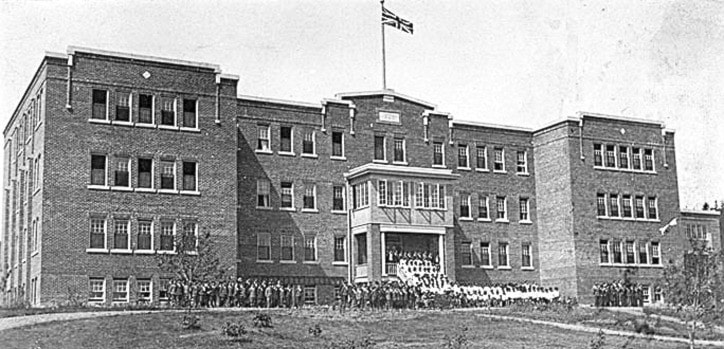The first Anglican mission, with day schooling, was started by the Reverend James Hall in Alert Bay in 1878. Hall previously supervised a mission based at Fort Rupert, but the trade at the Fort was lessening and Alert Bay had become home to a large First Nations population who worked at the local fish cannery/saltery.
The school boarding of First Nations children in Alert Bay started in 1882, and in 1891 the government set aside 412 acres on the island as the “Alert Bay Indian Industrial School Reserve.”
In 1929 an imposing new four-storey brick building was erected, called St. Michael’s Indian Residential School. It had a capacity of 200 pupils, although many more than this were reported to have been regularly squeezed into the facility.
Younger students attended school all day, while older students had a combination of schooling and work. Students generally graduated after grade 8. The school aimed to be self-sufficient and engaged students in farming. Students were punished for speaking their own languages and some missionaries referred to the children as ‘savages.’
The facility also housed a “Preventorium” for First Nations children from around the coast with tuberculosis, with a capacity of 18 students.
The school had pupils from as far away as Terrace, Prince Rupert, Haida Gwaii, Bella Bella and Bella Coola.
By the late 1940s there was increasing use of community or day schools around the coast, and the enrolment in residential schools began to decline.
In 1968 responsibility for the school was transferred from the Anglican Church to Indian Affairs. In 1975 the building was turned over to the ‘Namgis First Nation and in 2003 was renamed Namgis House.
Many former students of the school were taken from their homes at ages as young as 5 or 6 years, and prevented from speaking their language, practicing their culture and, in some cases, visiting their parents. Others have spoken about constant hunger and inadequate meals, and other horrible treatment, including physical and sexual abuse, endured while in the care of the residential school system. Some children became very sick and some died while at the school.
Many First Nations have stated that the legacy of the residential schools has been great suffering for individuals, families and communities. Today, residential schools are largely acknowledged as a misguided effort, and a regretful and dark part of Canadian history.
In 1993 the Anglican Church issued an apology with respect to its role in residential schools. On June 11, 2008, the Canadian government issued a formal apology for Canada’s role in the operation of residential schools. The Truth and Reconciliation Commission of Canada was also established as a part of the settlement of a class action lawsuit launched by residential school survivors from across Canada, and its work is ongoing today.
